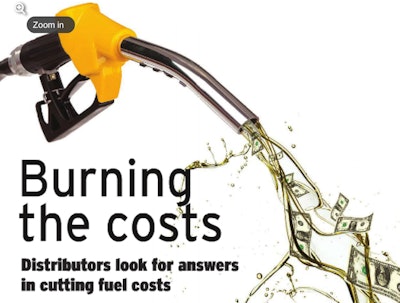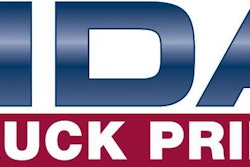The following comes from the April 2017 issue of Truck Parts & Service. To read a digital version of the magazine, please click the image below.

Like any business, aftermarket customers have many concerns and challenges during the business cycle.There are many that they control by building relationships, setting up new business processes or working through different avenues altogether.
But, there is always one challenge to overcome that is largely out of their hands.
Fuel prices.
The fluctuation of fuel prices is a constant headache for truck owners, just role in your customers’ ability to meet their invaluable. By stocking retrofitable aftermarket technology designed to lower fuel costs, independent distributors can offer customers a safety valve in the never-ending battle to control fuel costs.
Frank Jenkins, senior manager, Commercial and Heavy Duty Group at Denso, says the impact of fuel prices can be found nearly anywhere you look on a tractor and trailer.
“Fuel cost has a direct effect on the sales volume of some of our key products. CNG spark plugs, for example, are closely tied to the cost of fuel,” he says.
Denso isn’t alone.
Nearly every part sold in the aftermarket can impact fuel economy in one way or another. Finding parts that make a positive impact makes them much easier to sell.
Existing technologies and those in development offer a variety of cost-effective ways to increase truck fuel efficiency. These technologies include better diesel engines and transmissions, improved aerodynamics and tires, and hybrid technologies that improve the fuel efficiency of vehicles in stop-and-go operation. Many leading companies are introducing these technologies and taking other steps, such as reducing idling, to improve the fuel efficiency of their truck fleets.
Wind resistance is one of the top forces working against a truck as it runs down the road. Some of the other factors are grade resistance, tire rolling resistance, and engine accessory and/or drive-train losses, according to Cummins MPG Guide, “Secrets of better fuel economy.”
According to the guide, every 2 percent reduction in aerodynamic drag results in approximately 1 percent improvement in fuel economy. That’s why many distributors have unveiled aero-dynamic products to cut down on wind resistance, allowing the truck and trailer combination to carve a path toward fuel efficiency.
Walid Deir, project manager for Transtex, says his company has been working to create new aerodynamic products for the past decade, focusing heavily on side skirts, reducing wind resistance in the gaps between the tractor and trailer walls and at reducing drag behind the trailer.

“We have a lot of customers in the aftermarket who put these on their fleets that are already on the road because they are so easy to install.”
Jon Morrison, WABCO’s president for the Americas, says his company’s combination of tails and trailer skirts can lead to savings of up to 10 percent in fuel efficiency.
“That’s real money at the end of the day,” Morrison says. “We have a cooperation with Peloton working on a platoon-ing function. You can generate about a four-percent savings on the front vehicle and 10 percent on the second vehicle with that.”
WABCO’s OptiFlow AutoTail deploys and retracts tail panels based on driving speed as determined by sensors linked to WABCO’s Trailer Anti-Lock Braking Systems, Morrison says. The device automatically deploys at vehicle speeds of 45 mph ensuring it is consistently used at speeds that maximize aerodynamic fuel savings. The tail panels automatically retract at a vehicle speed of 10 mph. Morrison says the product alone can deliver fuel savings up to 4.3 percent.
“Aerodynamics plays a big part in the ability to cut down on costs,” he says.
But, aerodynamic technologyisn’t limited to trailer skirts.
The FlowBelow Tractor AeroKit was designed to include quick-release aerodynamic wheel covers. The pair of tandem fairings are installed on the tractor and work together as a complete aerodynamic system to address the complex airflow around the exposed rear wheels of the tractor, reducing turbulence and drag. The company says the Tractor AeroKit System reduces aerodynamic drag and improves fuel efficiency of the tractor by 2.23 percent, typically providing a return on investment for long-haul trucking fleets in one year or less. Those are figures that can be easily pitched to and understood by end users.
“Just as aerodynamics at the tail-end of the trailer is one of the most drag-intensive areas of the trailer, the rear of the tractor and the rotating drive wheels create an enormous amount of drag,” according to Josh Butler, president at FlowBelow Aero Inc.
“We’ve taken a different approach to reducing drag on the tractor by focusing on developing a complete system that controls the airflow around the tractor tandem.”
Other fuel efficient innovations have been developed over time.
Horton, for example, used its expertise as a producer of industrial clutches in the 1960s to enter the commercial trucking market with a product that could save fuel during the energy crisis of the 1970s, says Manish Virmani, Horton’s vice president of global market development.
By the 1980s, Horton fan drives were standard equipment for major truck OEMs.
Virmani says the fuel advantages of the product are easy to sell, and that what matters for distributors is teaching customers how to optimize a fan cycle to maximize fuel economy benefits.
One hour of idling consumes roughly a gallon of fuel for a heavy-duty vehicle, and a half-gallon for a light-duty one. Excessive idling also puts additional hours on engines, leading to more wear and tear and higher maintenance costs.
“We took the traditional on/off clutch and set it to where it has an idle speed or full speed. A lot of the times, trucks aren’t on highways or going up and down hills or the temperatures where they are may not require the fan to turn all the time,” says Virmani.
“Now we have a fan drive that you can get the exact speed you want and get a lot of savings in fuel. You can control temperatures to within one-degree Celsius, so the precision is extreme now.”
And the development of new products, aerodynamic or otherwise, will continue moving forward as customers’ demand increases in fuel economy and efficiency.
“The market dictates that we keep looking for ways to be environmentally friendly and fuel efficient,” Morrison says.

Each potential penny saved by new, efficient technology should be marketed and communicated to end users. As should unorthodox or non-obvious product usage.
Often fuel savings are created through a combination of products or designs. Distributors well versed on those combinations can present saving opportunities that customers may be unaware even exist.
“We have conducted studies and found that the use of a combination of our products can save up to 10 percent on fuel costs,” Morrison says, pointing to the company’s adaptive cruise control system, the clutch compressor electronic air processing unit, the electrically controlled air suspension and automated transmission.
Communicating how a customer drives can be beneficial as well.
Driving behaviors such as speed-ing, excessive idling, harsh braking and sudden acceleration burn more fuel and directly impact miles per gallon.
Fleet management software and onboard computers make it possible to automatically monitor for unsafe or fuel-wasting behaviors. Software can be configured to audibly alert drivers when they trigger an event so the driver can immediately self-correct the behavior.
Tools such as these are helping to alleviate the fuel costs and should be promoted and sold whenever possible in the aftermarket.
Virmani quoted Horton’s founder and Chairman of the Board, Hugh K. Schilling, by saying that “nothing saves money like ‘off.’”
By using products to reduce or cut “off” the elements that put resistance on a truck, real savings can be obtained.
“If you have a large fleet and you are incurring all these extra costs per year, that adds thousands of dollars in expenses,” Morrison says. “The demand is there to reduce transportation costs and cut the expenses passed on down to the consumer. The market is dictating that.”









